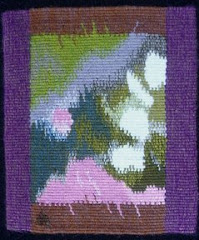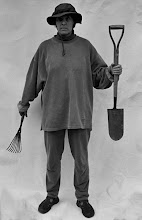Imagine getting a set of monumental tapestries for your birthday!
These were commissioned on Queen Margrethe II of Denmark’s 50th birthday and delivered in 2000 for her 60th. What anticipation! What excitement! What a price! $13,000,000 Danish Kroner (about $2,600,000).
You’d think they would be gorgeous, but then you might be a bit disappointed. Of course, one man’s meat is another man’s poison, or as my mother used to say “Everyone’s a bit strange except for me and thee and frankly, sometimes I wonder a bit about thee.” Anyway, I do hope the Queen loves them.
They are hanging in the Knight’s Hall at Christiansborg Palace, all 17 of them. The 11 large tapestries fit perfectly into the frames set into the marble paneling. The other 6 are smaller “entrefenetres,” which go between the windows. They were designed by the Danish sculptor Bjørn Nørgaard, and woven at the Gobelins and Beauvais studios in France. Here’s a link to some photos.
I was very impressed with the technical perfection of the weaving, but I don’t like the colors, style or compositions. The colors are garish, but perhaps I could learn to see them as luminous, or jewel-like, if the compositions didn’t seem completely disorganized. I know there is a tradition of medieval tapestries with very busy, even frenetic, compositions, but the really great ones are carefully worked out, balanced, fluid, graceful, and dynamic.
Some of the Queen’s tapestries, like “The Viking Age,” have an clearly defined structure, and I find that I’m beginning to like this one more and more.
Others, like “The Reformation,” come across as random and uninspired, with figures lined up in rows, as you can see below.
I object to the cartoony style of expression, particularly given the seriousness of the subject: the History of Denmark from the Viking Age to the Future. One of the tapestries, “Present,” depicts Queen Margrethe and her husband Prince Henrik, and their hands are about 3 times normal size. It makes them look awkward and unattractive, and it struck me as disrespectful.
Bjørn Nørgaard intended for these tapestries to be a lesson in Danish History, for recent generations who have not learned about it in school. He spent many hours devising a systematic plan for including innumerable narrative elements in each tapestry, and yet keeping a consistent formal structure over the entire project. He even chose to make full sized painted cartoons. He devoted 12 years to this project, so I feel bad about my (possibly uninformed) criticisms. Perhaps it’s a case of the intellectual concept over-riding purely visual or visceral concerns, or perhaps it’s just my taste.
I’m delighted that someone still wants to commission large original tapestries. These tapestries do fill up the large space in the Knight’s Hall, and the bright colors get your attention. Visitors seemed to enjoy puzzling over the diagrams provided, that explain all the people and objects and symbols in the tapestries.
I bought the book, “Tapestries for the Queen of Denmark,” (Peter Michael Hornung, ed.) and it’s very informative. I was pleased to see that it includes details about each tapestry, such as the name of the head weaver, number of shades of wool, time spent in preparation and weaving, number of weavers, dates, and size. It’s available used from Amazon.com.
Nørgaard seems quite respectful of the weavers, and knowledgeable about the process. I like this quotation from his interview in the book “….each and every square millimeter of these pictures is touched by human hand, and these people have invested their time in the tapestry. I believe quite naively that this is something you can read from the works. In a digital era with digital pictures, I think it is vital that we preserve pictures in which a great deal of time is invested.”
It’s sad that they spent such a huge amount of money, and so many years of artistic design and skilled weaving, to make something that is not beautiful. Given the number of brilliant tapestry weavers in Denmark, they could have had tapestries with the power to take your breath away; objects of exquisite beauty and grace.
I’d recommend visiting anyway, if you’re in the area, and I’d be curious to know how other tapestry weavers react. So far I have not spoken to anyone who disagreed with my position, but perhaps I’ll hear some dissenting opinions soon!







7 comments:
It is hard to comprehend spending that much money and not hitting a home run with it. Even if there are other opinions, there is a need to justify the unusual elements. I imagine you also went to the exhibit with great anticipation. Maybe some time and the other opinions will help make it more palatable?
Well, reading the book has clarified some things, but is not making me like the tapestries any better. Apparently the long arms and hands are symbolic of dynamisn....but if we don't know that they just look dorky.
I had read about these tapestries somewhere, but had never seen images. they are certainly not what I would have expected!
i have recently seen the tapestries in person & think they are fabulous. the colours could not be more vibrant, the figures more whimsical and imaginative. this is an incredible undertaking, but perhaps the style appeals less to an american eye than a danish one.
Thanks for weighing in, Alex. I think it's great that you like the tapestries. I agree that it is an incredible undertaking, and I guess it's just my personal taste that does not respond to the style or colors - vibrant and whimsical is a more positive description.
I was looking for some personal knowledge/ viewpoint about these tapestries as i was so delightfully surprised to come across them and wanted to know more about them. I still have not found out how such a provocative artist was chosen and who made the bold and enlightened decision to let him have carte blanche on the subject matter. I think these tapestries can not be seen simply in the context of their traditional craft, neither in terms of color, composition or subject. Imho, it was a brilliant decision to have these made in this way. After a tour through an interesting but ultimately dull palace , i was rejuvenated by the colors of the works that shone like stained glass, the compositions that held my fascinated gaze for a long eye journey, and subject matters that were brought to life by this modern rendition. I spent the time there and the days after researching Danish history, which until that point had zero interest for me. I believe these tapestries were brought into being by modern tastes for symbolic ingestion and short attention spans. They do what art does best, confront communicate fascinate and awaken curiosity. Perhaps you will look at them again with a fresh eye. Perhaps not. But for me, they actually made me interested in history which was never an interest of mine beyond curiosity of cause and effect. Here in one tableau we have the seeds of a hundred fascinating stories
Thank you so much for your comment, Serafine. I wrote this post a long time ago, and looking back, I can see that I disappointed because I was anticipating something more atmospheric, like the amazing contemporary Danish tapestry weavers I know. I am happy to know that the Queen's tapestries have had such a positive effect on you, and presumably on many others! To learn more about contemporary Danish tapestry check out this recent online exhibit at www.americantapestryalliance.org/exhibitions/tex_ata/over-the-sea-under-the-sky-contemporary-danish-tapestry/
Post a Comment